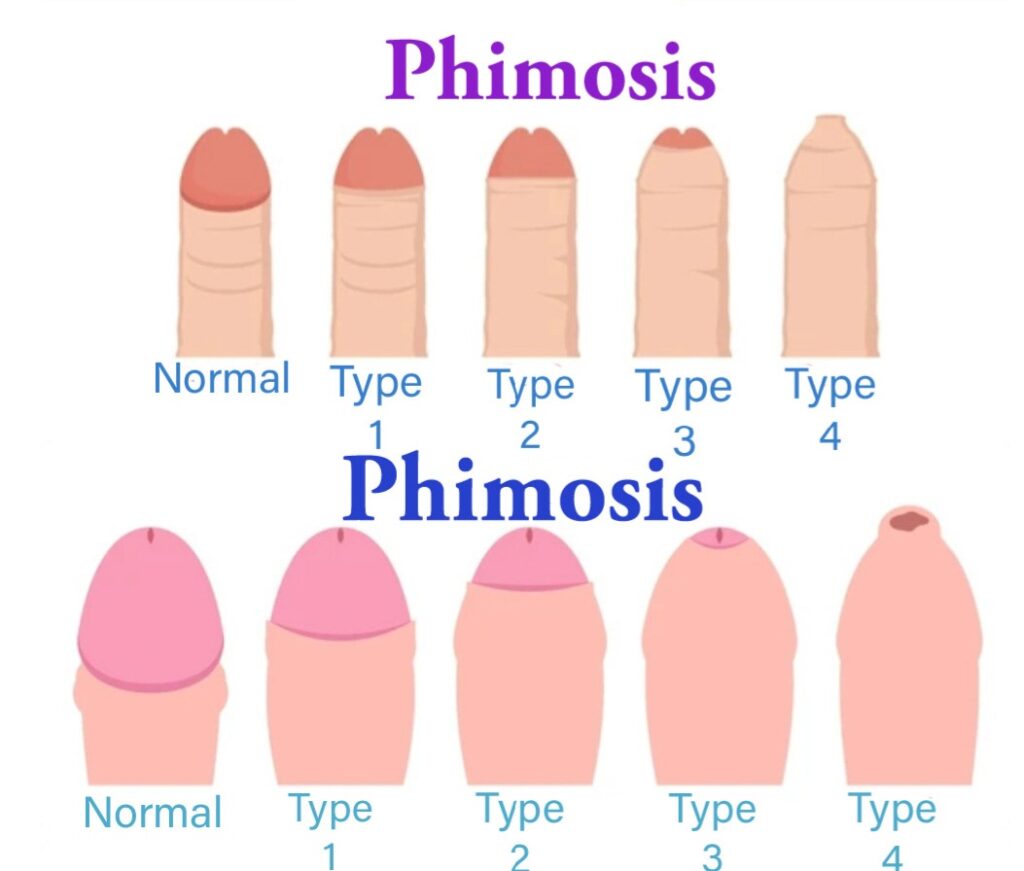What is Phimosis?
Phimosis is a condition in males where the foreskin of the penis is too tight to be pulled back (retracted) over the glans (head of the penis). It is normal in infants and young boys, but in older boys and adults, it can sometimes cause issues.
Types of Phimosis
Physiological Phimosis:
Natural in babies and young kids. The foreskin is fused to the glans at birth and usually separates on its own by age 3-7 as the child grows. No treatment needed unless it persists abnormally.
Pathological Phimosis:
Occurs later in life due to scarring, infection, or injury. This is the type that might need attention.

Symptoms of Phimosis
- Tight foreskin that won’t retract fully or at all.
- Pain or discomfort during erections or sex if retraction is forced.
- Difficulty cleaning under the foreskin, leading to irritation or infections (e.g., balanitis).
- In severe cases, trouble urinating (e.g., a weak stream or ballooning of the foreskin).
Causes of Phimosis
In Kids:
- Usually just natural development—nothing to worry about unless it doesn’t resolve with age.
In Adults/Teens:
- Scarring from repeated infections (like balanitis) or rough handling.
- Chronic inflammation (e.g., from poor hygiene or skin conditions like lichen sclerosus).
- Injury or trauma to the foreskin.
- Rarely, congenital issues that didn’t resolve.
Complications of Phimosis
- Recurrent infections if trapped moisture or bacteria build up.
- Painful sex or erections.
- Paraphimosis (a medical emergency where the foreskin gets stuck retracted, cutting off blood flow—seek help immediately if this happens).
When to See a Sexologist
- If it’s painful, causes infections, or affects urination/sex.
- If the foreskin gets stuck (retracted or not)—especially if swollen or discolored.
- If it suddenly worsens (e.g., after an injury or infection).
Treatment of Phimosis
Depends on severity and age:
No Treatment:
If it’s not causing problems (e.g., no pain, infections, or urinary issues), it can be left alone. Some men live with mild phimosis without issue.
Non-Surgical:
Stretching: Gently stretching the foreskin over time (done manually or with special tools) can work for mild cases. Takes weeks to months. Don’t force it—tearing makes it worse.
Steroid Creams: Prescription creams (e.g., hydrocortisone) can soften the skin and improve elasticity. Often paired with stretching. Success rate is decent (up to 70-90% in mild cases).
Hygiene: Regular cleaning (without forcing retraction) to prevent infections.
Surgical:
Circumcision: Removes the foreskin entirely. Common for severe or recurrent cases, especially with scarring. Quick fix but permanent.
Preputioplasty: A less invasive surgery that cuts and widens the foreskin without removing it. Good for those wanting to keep it.
 Dr. SP Singh Clinic[/caption]
Dr. SP Singh Clinic[/caption]